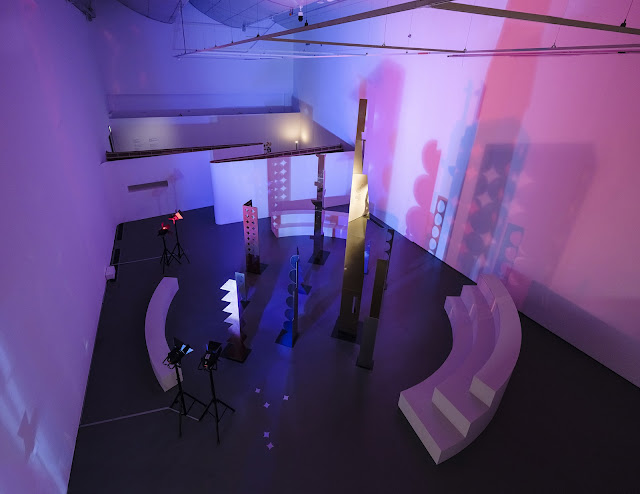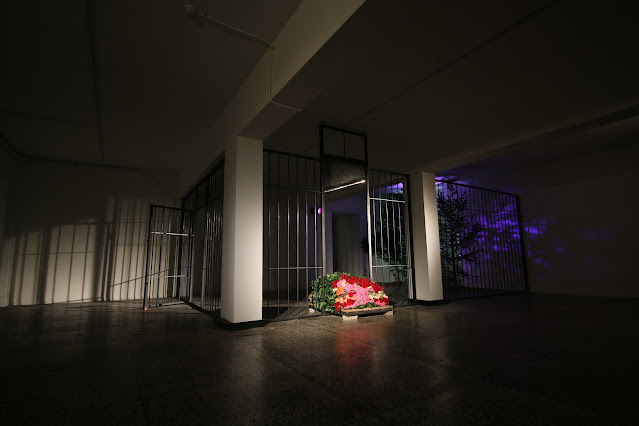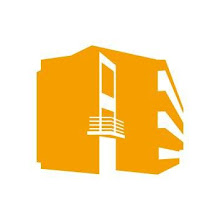□ E-mail / partysiha@gmail.com
□ Web / https://www.sihakim.com
□ SNS / @sihakim_studio
Biography
Siha kim visualizes the sensations of “saturated space”—a realm charged with the tensions between nature and artificiality, visibility and invisibility, fact and fiction. Her works embody the subtle differences, gaps, oppression, violence, dissonance, and psychological anxieties that arise within these dualities, constructing what she calls a “stage-poetic landscape.”Focusing on the emotions and perceptions emerging from contemporary omnipresent environments, Siha Kim employs theatrical elements in her sculptural and installation works to create a timeless, stage-like poetic forest where humans, nature, and objects intertwine.Her practice blurs the boundaries between reality and unreality, exploring emotions of loss and trauma through what she terms “disaster psychodramas.” Additionally, she produces sculptures that interrogate the thresholds between utility and uselessness. Rather than adhering to a fixed artistic format, Kim's work unfolds through diverse variations, responding to themes such as femininity, violence, and catastrophe.
Piece of Sculpture, Stain_Steel_LED Light_Heat paint, Variable size, 2023
Piece of Sculpture, Stain_Steel_Brass_Titaum_PAR light_Wood_Mixed, Variable size, 2022
Exhibition view of Piece of Sculpture (Gyeonggi Museum of Art, 2022)
Lost Garden, Steel pipe_Sportlight_Sculpture_Text_Mixed media, 300x150x310cm(Variable), 2024
Blood heat, Stain_Steel_Par light_Led Light, Variable size , 2021
Our Eyes Asking for Your Wellness, Steel_Bark_Sun Light, 700x700x80cm, (Taehwa ECO Art Festival, 2021)
Burn, Stainness_Steel, Glass, Wood, Charcoal, Concrete_Neon_Light Mixed, Variable size, 2020
The Sand Darkened and Whitened, Turned Blue and Red-Twins on Stage Act1, Space xx, Mixed media, Variable size, 2017
Visual Garden, Mixed media, Variable size,(Culture Station Seoul284 RTO Space, 2014)
Education
2001 Contemporart Art Reserch course, Kaywon scool of Art and Design, Korea
1997 BA Kyunghee University Sculpture , Seoul, Korea
Solo Exhibitions
2024 Rosy theater_After, The square Nonhyun, Seoul, Korea
2023 Piece of Sculpture_an Unexpected Future, All time space, Seoul, Korea
2022 Burning My little forest, Pageroom8, Seoul, Korea
2020 BURN, Cr-collective, Seoul, Korea
2017 The Sand Darkened and Whitened, Turned Blue and Red-Twins on Stage Act1, Space xx, Seoul, Korea
2016 Twins on Stage_Prologue, Lespase71 gallery, Seoul, Korea
2014 Visual Garden, Culture Station Seoul284 RTO Space, Seoul, Korea
2012 Real Fantasy, Kunstdoc gallery, Seoul, Korea
2010 The Twinkle of time, Songeun Art Cube, Seoul, Korea
2008 Fengzhengquan, Sihakim, Match Exhibition, gallery TN, Seoul, Korea
Group Exhibitions
2024 Amidst the living and the dead , Art moment, Seoul, Korea
2024 Eco Art Festival: Shelter for All, Agnes park, Geoje, Korea
2023 Langue of Slum_Prologue, All time space, Seoul, Korea
2022 New Moon _Gyeonggi Artist Highlight Exhibition, Gyeonggi Museum of Modern Art, Korea
2022 Irreplaceable Reality:□☞∴∂★∽Collective, Cr-Collective, Seoul, Korea
2021 Round-Round- Round: GEUMCHEON-GU, Online exhibition, Geumcheon Foundation Arts and Culture, Seoul, Korea
2021 "Unhidden/Unseeable“ Taehwa River Eco Art Festival2021(TEAF2021) Taehwagang National Gadren,
Ulsan, Korea
2021 [ ? ] Balance of Mass and Acceleration, Art Moment, Doksan, Seoul, Korea
2020 8 Artists Voyage, Sungnam Art Center Cube Museum, Sungnam, Korea
2020 Song of Myself, Savina Museum of Contemporary Art, Seoul, Korea
2019 Roadshow 2019 “From Shanghai to Chongqing”, Korea Culture Center, Shanghai, China/ Total Museum of Contemporary Art, Seoul, Korea/
2019 Over Drive 2009~2019 Traveling Subjects, Creators, Experience of Places, Incheon Art Platform, Incheon, Korea
2019 YokYokYok, Time Motel, Seoul, Korea
2018 Between you and me, Shinhan Gallery, Seoul, Korea
2018 “The Dictionary of Evil” Gqngwon International Biennale, Gangneung eco center, Gangneung,
Korea
2017 Taehwa Eco River Art festival “Diversity&Hybridizing”, Taehwa Park, Ulsan, Korea
2016 AR-Towns, Hwangji Restaurant, Jeju island, Korea
2016 + -Beachcoming One week Jeju Beach residency Exhibition, Twinkle Earth shop, Jeju island, Korea
2016 Room number 88-290_Looking for secret, Miari Texas project, Seoul, Korea
2016 “Do the right thing” The 5th Annual commemoration Woman’s day, Glendale, California, USA
2016 Two landscape One world, Korean culture center, Beijing, China
2014 Play of the space-moment, Sungsan art hall, Changwon, Korea
2014 Incheon Art Club, Inceon Art Platform, Korea
2013 The breath of fresh, Gyeonggi Museum of Modern Art, Gyeonggi, Korea
2013 Rebot vol.24 Showcase, Platoon kunstalle showcase, Seoul, Korea
2012 Hyeyandong10-1, Incheon art platform, Korea
2012 Why did Sprite float off the coast of Incheon, Incheon art platform, Korea
2012 Fantastic story, Gallery two, Hongkong
2011 Hello,Jungjaeuk,Kimsiha Duo Show, Space15, Seoul, Korea
2011 His, Her Stories, MK2 gallery, Chaochangdi, Beijing, China
2011 ‘Art’ 7th Songzhuang Art Festival, limitans Art Center, Songzhuang, Beijing, China
2011 Look up!!, Force gallery, Beijing798, China
2010 PINGYAO International Photo Festival, Pingyao, Sansi, China
2010 Moving sense, Korean culture art center, Beijing, China
2010 ‘Cross over’ 6th Songzhuang Art Festival, Hongan art center, Songzhuang, Beijing, China
2009 She’s vision, Jiangshan Museum, Qisheng gallery, Chongqing, Chengdu, China
2009 The meaning of meals-eight stories, Goyang Aram Nuri Museum, Gyeonggi, Korea
2009 ATTENTION, Zaha museum of Art, Seoul, Korea
2009 Playing with Art, Korean culture art center, Beijing, China
2009 Destructive Character3, Space da, Beijing, China
2008 Chinese language biennale, KU Art Center, Beijing, China
2008 Propose 7 vol3, Kumho Museum of Art, Seoul, Korea
2007 The Art of Packaging, The space Gallery, Seoul, Korea
2005 Domestic drama, project space zip, Seoul, Korea
2005 Alchemy of daily life, Cristchurch Art Gallery, Newzeland
2005 15 Village story, Junlanamdo Provincial government, Gwangju, Korea
2004 Alchemy of daily life, National Museum of Modern and Contemporary Art (MMCA), Korea
2004 Museum spring picnic, Seoul Museum of art, Seoul, Korea
2003 Energy, Project Space Zip. Seoul, Korea
etc.......
Other Projects
2023 Langue of Slum_Prologue, Curator, All time space, Seoul, Korea
2019 YokYokYok, Curator, Time Motel, Seoul, Korea
2018 Crytos, Curator, SeMA Nanji Residency, Seoul, Korea
2016 Two landscape One world, Curator, Korean culture center, Beijing,
2016 Room number 88-290_Looking for secret, Curator, Miari Texas project, Seoul, Korea
2011 Red Land’ 1st Jiangxi culture art festival, Korea Part Curator, Jiangxi culture museum, Nanchang culture art center Jiangxi, China
2009 Playing with Art, Curating of Cooperation, Korean culture art center, Beijing, China
2007 Handspan Gallery_Gongdan Subway Station Purblic Art Project, Gyeonggi Museum of Art, Korea
2022 Who Forces you to make your choice, Section Interviewee, Korea
2017 Twins on Stage, Seoul Museum of Art & Total Museum of Contemporary Art, Korea
2006 Blooming young art, Davinci gift, Korea
Residencies
2025 SFAC Seoul Art Space Geumcheon Art Residency, Seoul, Korea
2018 SeMA Nanji Residency, Seoul, Korea
2016 One week Jeju Beach residency, Jeju island, Korea
2014. TAV, Taipei artist village, Taipei, Taiwan
2012 IAP Incheon art platform, Incheon, Korea
2009 KU art residency 1st artist, Beijing, China
2008. MMCA National Museum Contemporary of Art, IASK Goyang international studio , Korea
Grants&Awards
2022 Gyeonggi Artist Highlight Support, Gyeonggi Culture Foundation, Gyeonggi Museum of Modern Art, Korea
2020 Art Chane-Up, Online Support, Art Council Korea
2020 Grant for Visual Art, Gyeonggi Culture Foundation, Gyeonggi, Korea
2017 SeMA Emerging Artist &Curators Supporting Program, Seoul Museum of Art, Korea
2016 Grant for Visual Art, Seoul Culture Foundation, Korea
2014 Grant for International Exchange of Arts &Culture, Arts Council Korea
2013 Grant for Visual Art, Gyeonggi Culture Foundation, Gyeonggi, Korea
2010 Support Songeun Art Cube Exhibition, Songeun Art &Culture Foundation, Seoul
Collections
Cr-Collective, Seoul, Korea
Art Moment, Seoul, Korea
GOP Graphite on Pink, Seoul, Korea
Gyeonggi Culture Foundation, Korea
MMCA National Museum Contemporary of Art-Art Bank, Seoul, Korea
KU-Art, Beijing, China
Wang Restruant, Hongkong
&Private Collection.



%20%EC%A0%84%EC%8B%9C%EC%A0%84%EA%B2%BD%20.jpg)
,%202024.jpg)

.jpg)


.jpg)





















